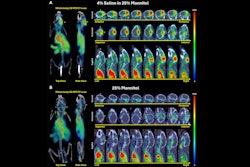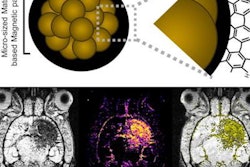
A diffusion-weighted MRI technique may help clinicians predict the course of cerebral small-vessel disease by tracking changes in the blood-brain barrier, according to a study published March 24 in Neurology.
The results with the protocol, called intravoxel incoherent motion imaging (IVIM), show promise for a way to identify patients at risk of tissue degeneration, wrote a team led by Dr. Danielle Kerkhofs of Maastricht University Medical Center in the Netherlands.
"Our results support the hypothesis that blood-brain barrier impairment might play an early role in subsequent microstructural white-matter degeneration as part of the pathophysiology of cerebral small-vessel disease," the group wrote.
Cerebral small-vessel disease consists of changes in tiny blood vessels in the brain as people age, and it can lead to cognitive and memory problems as well as stroke, according to the investigators. The blood vessel changes may affect the blood-brain barrier, which protects the brain from toxins that circulate in the blood.
In their study, Kerkhofs and colleagues sought to assess whether there was a link between the level of blood-brain barrier leakage and the severity of cerebral small-vessel disease.
"People with cerebral small-vessel disease also may have brain lesions called white matter hyperintensities," Kerkhofs said in a statement released by the university. "Such lesions are visible by MRI and believed to be signs of brain damage and a marker of the severity of disease. For our study, we wanted to see if a leaky blood-brain barrier was linked to degeneration of brain tissue even before these brain lesions appear."
The study included 43 people with cerebral small-vessel disease. All participants underwent an MRI exam at the start of the study, using both dynamic contrast to measure blood-brain barrier leakiness and intravoxel incoherent motion imaging to measure the health of the tissue surrounding brain lesions. The patients then had another MRI using the IVIM technique two years later to assess whether the brain tissue health had degraded or not.
The group found that patients with higher tissue volume with blood-brain barrier leakage at the start of the study had greater loss of integrity in the tissue surrounding brain lesions two years later by 1.4%. The researchers also found that patients with a higher leakage rate at the beginning of the study had more microtissue loss two years later.
"In the future, measures of blood-brain barrier leakage may be used to identify patients at risk for development and progression of tissue degeneration," they concluded. "The longitudinal change in parenchymal diffusivity measured with IVIM is a promising quantitative biomarker for monitoring in cerebral small-vessel disease trials."




.fFmgij6Hin.png?auto=compress%2Cformat&fit=crop&h=100&q=70&w=100)




.fFmgij6Hin.png?auto=compress%2Cformat&fit=crop&h=167&q=70&w=250)











